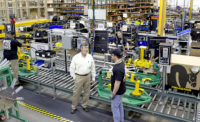One such manufacturer is Caterpillar Inc. (Peoria, IL). The heavy-equipment manufacturer has long had a corporate commitment to environment. In a 1992 corporate publication, Caterpillar pledged to "incorporate environmental considerations into design and manufacturing processes...and develop and apply technologies and processes that prevent pollution and minimize waste."
One way the company is fulfilling that promise is through remanufacturing engines and engine components. Caterpillar’s remanufacturing operations began in 1972, and the company now operates three remanufacturing facilities in Corinth, MS, and Prentiss, MS.
The Sawyer Road plant in Corinth serves as a central receiving point for worn assemblies from all over the country. Each day, Caterpillar dealers send the plant an average of 160 tons of assemblies for remanufacture, including engines, hydraulic assemblies, cylinder packs, water pumps, fuel pumps, oil coolers and injectors. These assemblies are cleaned, sorted and sent to the other two plants.
The Cardinal Drive plant in Corinth remanufactures diesel engines, crankshafts, blocks and other components. The plant remanufactures eight engine models in multiple variations. Remanufactured engines are brought up to current design standards and tested before shipment. The receive the same warranty as new engines. Caterpillar estimates that one of its engines can be remanufactured at least three times before it cannot be used again.
Because not all components are recoverable, new parts are used where necessary. For example, 32 percent of remanufactured cylinder blocks is new material, and 45 percent of remanufactured cylinder heads is new material. What can’t be reused is sent to the company’s foundry in Mapleton, IL. In 1999, the foundry recycled 235,526 pounds of aluminum alloy, 16,865,767 pounds of cast iron and 5,680,509 pounds of steel.
Most of the refurbishment of engine components consists of building up worn surfaces by thermal spraying, laser cladding and welding. The surfaces are then machined, ground and honed to new surfaces. Many components are designed to permit one or two remanufacturing operations without adding surface material. Caterpillar has developed a proprietary process for repairing cast iron cylinder heads, and it can repair small holes in engine blocks that result when the engine throws a rod. Caterpillar is also trying to eliminate chrome plating operations by the use of thermal spraying.
Cleaning operations involve removing oil and grease, carbon build-up, paint and rust. A mixture of baking soda and 10 percent alumina grit to remove these contaminants. The liquid waste from the cleaning process is sent to a facility that uses it as a reagent in the neutralization of acidic liquid wastes from other companies, so this waste is not considered to be hazardous. Even so, Caterpillar has reduced its liquid waste from 9 million pounds per year to 4.5 million pounds per year. Whatever packaging material that Caterpillar can’t reuse is sold to other manufacturers.
Caterpillar has won several pollution prevention awards and has been recognized by the state of Mississippi for its recycling efforts. Once a year, the company holds an "amnesty day," during which members of the community can bring hazardous materials, such as paints and thinners, to the community collection site, where Caterpillar helps others to dispose of them. The company also started an Earth Day celebration for area fourth graders.
The Prentiss plant remanufactures pumps, cylinder packs, connecting rods and oil coolers. Components such as turbochargers, starters, alternators, governors and compressors, are returned to the OEMs, as are transmissions, clutch plates, brakes, hydraulic cylinders and rods, and electronics.
Plant personnel have identified several areas where technology is needed to improve remanufacturing yields. These include:
- Process modeling for improved accuracy. For example, to model a weld repair of compacted graphite iron.
- Reduced energy consumption, particularly for preheating weldments.
- Higher strength materials, especially those for surface restoration.
- Reduced emissions from welding fumes.
- Low-cost methods for detecting cracks in castings and forgings.
- Models to predict remaining fatigue life of components.
- Methods to separate metal particles from blast media.
- Paints and coatings that can be removed for remanufacturing.

